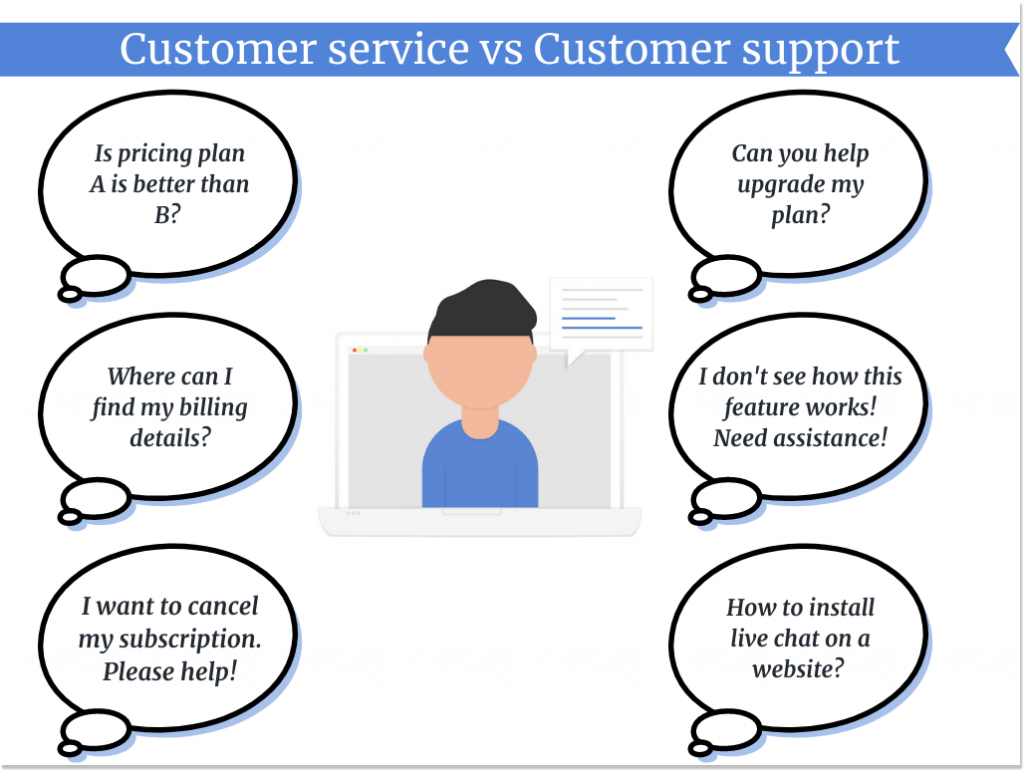Customer Service vs Customer Support: Exploring the Difference
Yes, there's a difference between customer service and customer support (a slight one, but still). Click to find out all the details and decide what team you are on.
Written by Olesia Melnichenko

Some might think that comparing customer service to customer support is comparing like with like. My guess is that placing them against each other is talking about apples and oranges. Here’s why.
Yeah, they both aim at helping clients, achieving their goals, and increasing customer satisfaction. Does it really matter how you call the department? Probably, that’s you who decide (only after reading this piece you’ll puzzle that out). What really matters is enough attention to customers and the ability to resolve their every query.
If you start digging deeper, you’ll see that despite some crossover, customer service and customer support should be perceived differently. We are going to draw a parallel between them.
What is customer service?
Customer service revolves around clients and the way brands meet their needs. It’s an umbrella term for all the assistance, pieces of advice, and practical tips you give to a user who comes with questions.
As a rule of thumb, customer service queries don’t have a technical side and may be connected to shipping details, billing procedures, checkout problems, to name just a few.
However, clients aren’t the only ones who should be mentioned in this context. Your team should comply with certain standards in customer service so that their performance is over-the-top. Even if it’s an outsourced customer service team. Let me unpack that for you.
Clients are now more demanding than ever, so no doubt a service rep should be agile to handle their requests as quickly as possible.
Your team’s expertise is even off the table. Who wants to be assisted by a nonpro? We’ve all heard about customer service horror stories, and don’t want to be involved in them at any time.
And last but not least is precision in a service agent’s work. Imagine the client’s disappointment when they get the wrong advice. So, my TOP 3 standards I would recommend you to follow are speed, professionalism, and accuracy.
There is also such thing as customer service mindset, which implies not just quick issue resolution but also genuine care about user satisfaction and needs.
What is customer support?
According to Techopedia, customer support service efforts from technology vendors and providers that focus on helping customers to use products and services correctly, efficiently and effectively. Many see this specific type of support as part of a larger category of customer service, but while customer support is often provided in response to customer demand, it is also part of intelligent planning for a wide variety of IT companies.
Just like customer service, customer support should have a personal touch so that clients feel they are into a one-to-one conversation with a brand.
Make your support team skilled specialists and you’ll notice the benefits: happy and engaged customers who are always ready to provide feedback.
As you can see, customer service vs customer support definitions are alike, but there’s a fine balance. If you deliver support on how to use products properly, correctly, and efficiently, you’re in a customer support team.
But if you shift focus to helping clients make their buying decisions, welcome to a customer service squad.
To better understand the difference between support and service, there’re common questions clients usually pose:

Customer service vs customer support
The distinction between customer service and support goes way beyond merely their definitions. Yes, they both are about a client.
Their approach, however, should be looked at through a broader lens. Though it may be a lot to take in, a customer support vs customer service table will help make things as clear as bell.
| Customer Service | Customer Support |
| A rep usually falls back on a customer service oriented way of thinking and strives to build a good rapport with clients and provide guidance throughout their lifecycle. | Being a customer support agent, you deal with rather technical problems a client has (caring about the proper functioning of the product). It means that customer support is business-oriented. |
| Common activities are: – Onboarding new users – Managing customer comments on social media or answering questions in direct messages – Helping with billing issues, shipping, etc – Handling non-technical account issues – Gathering customer feedback and reviews – Upselling if needed |
Common activities are: – Real-time troubleshooting via live chat, emails, or phone – Helping clients install, upgrade, maintain the product or service – Writing product documentation (for instance, knowledge base articles) – Performing usability studies – Сontributing to product development |
| Proactive and long-term interactions, meaning that a service agent anticipates a client’s issue and shows their initiative first. | Reactive and short-term interactions, meaning that a customer reaches out with a problem and a support rep finds an ultimate solution. |
| To measure customer service, you need to keep track of: – Customer satisfaction metrics – First response time – Ticket volume – Average handle time |
To check if your customer support operates well, track all customer service metrics plus: – Net Promoter Score (NPS) – Churn rate – Customer effort score |
| Positions are commonly spread in any industry that serves clients (banking, hospitality, retail, etc). | Positions are mostly found in SaaS or e-commerce. |
What ties together customer service and customer support
Positive customer experience always makes for good word of mouth. And it’s the bottom line for customer service and customer support. Here come some numbers:
- 84% of companies that work to enhance their customer experience grow their revenue significantly
- 96% of consumers say customer service and support are important in their choice of a loyal brand
- 77% of clients claim insufficient experiences detract from their quality of life
What I wanted to say is that no matter how you view your business, creating favorable experiences for your users should be a top-of-mind priority. How to do that? It’s simple.
Everything boils down to creating customer intimacy, capturing your client’s feedback, optimizing the user journey, and optimizing your workflow. And all this rests on managing support and service teams.
Customer service and customer support alternative names
Though the difference between customer service and customer support DOES exist (a slight one, but still), you don’t need to limit yourself to just these two terms.
There are dozens of other synonyms business owners use as an alternative. It all depends on the way you want to be called and your primary goals. Have a look at the list:
- Customer assistance
- Customer care
- Customer support services
- Customer success
- Support services
- Customer management
- After-sale service
- Help line
- CS
- Product service
Final thoughts
Without quality customer support and customer service, you won’t reach harmony in business. Engage with clients better, polish your expertise to omit churn and boost retention.
Though these two terms are often mixed up, remember that one thing that knit them together is the willingness to go the extra mile for your customers at all costs.
And doing just that is impossible without an advanced toolset. Create a free account with HelpCrunch to offer clients what they really want and deliver ultimate help via your preferred channel.





